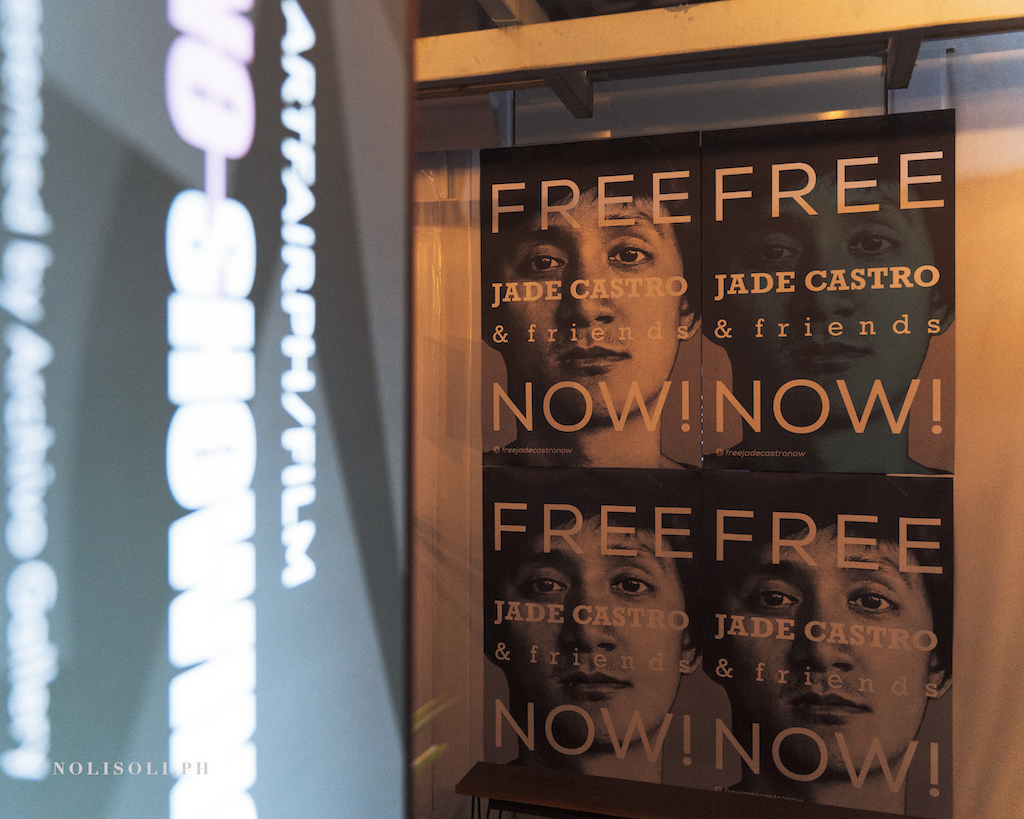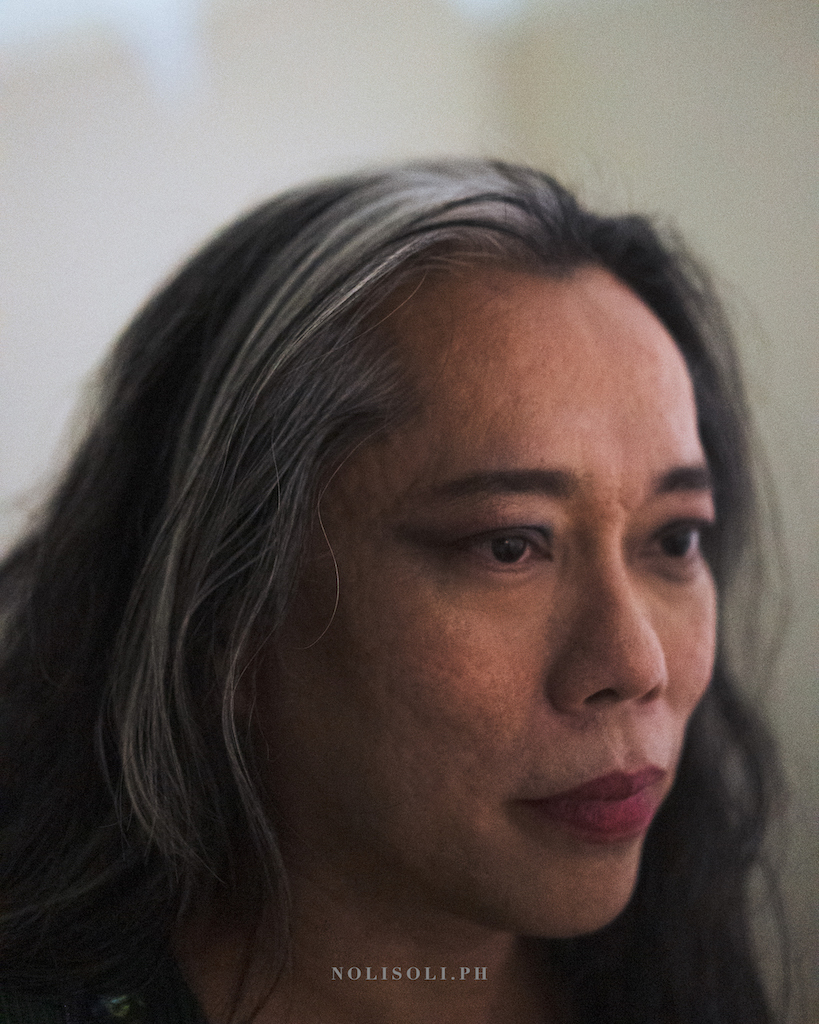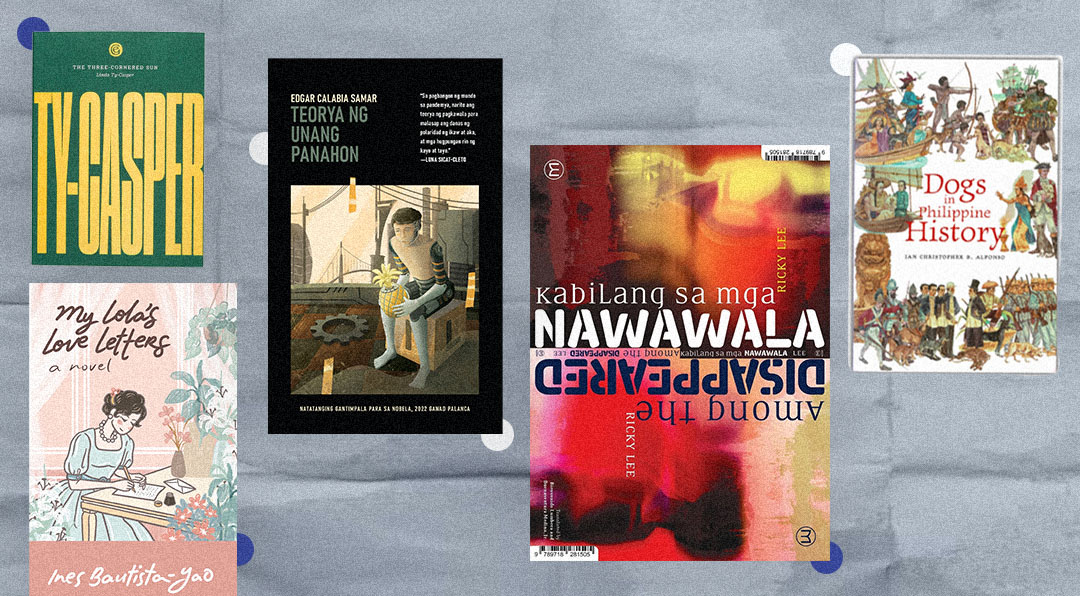At her “No Showing” film space at Art Fair Philippines, Moira Lang talks about the value of seemingly inconsequential conversations, why word of mouth trumps critics’ reviews, and the case for lowering movie ticket prices
This interview with Moira Lang almost didn’t happen.
It wasn’t just because of her busy schedule (which is actually a plausible reason given how she’s an omnipresent force in Philippine cinema). It’s in the same vein but more pressing.
If you were at the roof deck at this year’s Art Fair Philippines vernissage, you might have caught the filmmaker putting up “Free Jade Castro & friends NOW!” posters, all while keeping guests company. While we initially planned a virtual correspondence with Lang days prior, she had to prioritize attending to the case of her friend and fellow filmmaker. Together with three other individuals, Castro was arrested without a warrant on Jan. 31 for allegedly burning a modern jeepney in Catanauan, Quezon, and is still in police custody as of writing.
During an exclusive chat with Nolisoli a day before her film section’s official opening, Lang was more than open to talk about it: “Ang daming evidence, including CCTV footage and sworn statements ng witnesses na kasama nila at the exact time na may sinusunog palang jeep sa kabilang bayan. So bakit nandoon pa rin sila sa jail hanggang ngayon?”

Speaking about her recent visit to Castro, she said that despite being in jail, the filmmaker is still in high spirits. “Kasi kami sobrang lungkot for him, pero no’ng nakita namin na masaya siya noong nandoon kami, tawa siya nang tawa. Sabi ko, ‘May bagong pangalan ka na ngayon: Jailed Castro.’ Siya ang may pinakamalakas na tawa, grabe. Nagulat ‘yong pulis eh,” she quips. “This is an instance where real life is a lot stranger than fiction. This reality that Jade is going through right now is a lot stranger than any of our movies.”
Movies are also the reason why we reached out to her in the first place. Under Art Fair Philippines 2024’s special projects is “No Showing,” a “hangout/speakeasy/watering hole/listening party/dance floor/breathing space”—everything but a screening room—curated by Lang together with Archivo Gallery and Club Kino.
“I noticed that during art fairs, I mean, there would be a lot of interest in watching films, but you kind of get distracted. There are a lot of things going on outside, and even if it’s a short film, sometimes your attention is divided. So feel ko this year, let’s take a pause, and just talk, just hang out,” Lang points out, which feels apt for an era of self-proclaimed overstimulated people. “We can still talk about our films. We can even show parts of our films on our phones while talking to each other, right? ‘Yon ’yong sinuggest ko na what if we have a section where we don’t show films? What will that look like or feel like?”
I really have a bias for the underseen. Mas nandoon ako. Kasi kung marami nang gumagawa ng similar, I’d rather just be a movie fan—which I am. I just watch.
And if it seems strange that a film section is without screenings, hear Lang out first: “I think it’s still a legitimate representation of filmmaking today in our country if it’s about us filmmakers doing what we love best aside from making films: hanging out with one another and just talking and talking and talking. Talking the night away while drinking. This all seems inconsequential and playful, but actually, during these hangouts, a lot of things get resolved, confronted, questioned, challenged. We need to do that.”
A free-flowing event, “No Showing” is also meant for “comparing notes” on the state of Philippine cinema. This could mean confronting multiple elephants in the room, she says: “How can we do things better? How can we sustain this practice? Why are we still at it? If it’s so hard, what makes us keep at it? What makes us stay? Are you masochists?”

And what better way to do this than sharing the space with the industry’s biggest names? Joyce Bernal, Erik Matti, Quark Henares (who will also DJ on Feb. 17), Roxlee (Roque Federizon Lee), and Soliman Cruz, among others, are expected to grace the “No Showing” during its weekend-long run.
Important conversations have always been a backbone of film. Eavesdropping on strangers can become “lightbulb moments” before a polished blockbuster premise. Post-movie-watching reviews turn into real-life catalysts. And with the alarming issues surrounding the industry, conversations also serve to amplify voices and create calls to action—either for a fellow filmmaker or a friend.
As “No Showing” officially opens its doors to make room for more of these exchanges, we continued probing Moira’s thoughts on local cinema, Letterboxd, and an upcoming project (Spoiler alert: It involves dance).
This interview has been edited for clarity
Hi Moira! Comparing notes on the state of Philippine cinema, can we take a peek at yours? What are your thoughts on the current scene? Is there anything that stands out for you?
For me, ang cinema it’s not just limited to the 90-minute or two-hour format or a bit longer. ‘Yong ibang series na ginagawa, it’s also cinema. Kasi ‘yong length, is arbitrary. Cinema is cinema. I think ngayon naging wider ang canvas ng filmmakers, that we can tell cinematic stories even on a series length. Tsaka regardless of length, feel ko ang exciting na there’s a format as short as TikTok and as long as a Korean drama if we’re telling stories.
I think interesting din tingnan ‘yong mga ginagawang short films and student films outside Manila. Nagamit na often ‘yong phrase na “regional cinema” and I like it, but also baka gusto ko rin makarinig more often ng “community filmmaking.” It doesn’t have to represent the whole region, but it can just represent your neighborhood, your street.
‘Yong technology right now, even with cellphones you can shoot a movie. So parang feeling ko, bakit hindi natin i-empower ‘yong storytellers. We don’t have to have a degree in film to make a film. To tell a story on film. Gusto kong i-encourage and emphasize ‘yong community films.
Parang ‘di pala maganda pakinggan ‘yong “community films,” parang community center. Iisip pa ako ng magandang word na mas sexy. But what I mean is, you know, it doesn’t have to be competitive in nature. Not “Are you Manila or not Manila?” Not them versus us. Ito, it’s just intimate, very real stories.
What are themes of cinema that you wish more people would focus on?
Sa’kin kasi, as long as there are imbalances and gaps, I’d like to address those. Before, there really was a dearth of films about the LGBT story, and lately dumadami and I love that. I’m not saying there’s too much already or that there’s even enough; I think there needs to be more. And more different, of the different colors of the rainbow, not just one type of LGBT, or two types. But all colors of the rainbow.
[READ: ‘Ang Pagdadalaga ni Maximo Oliveros‘’s Moira Lang: Film can be a good medium for advocacy]
And stories of the marginalized or underseen groups or aspects of our lives as Filipinos. Ang dami pang puwedeng i-explore. I really have a bias for the underseen. Mas nandoon ako. Kasi kung marami nang gumagawa ng similar, I’d rather just be a movie fan—which I am. I just watch. If I’m gonna make something, I’d rather make [it about] something na wala masyadong pumapansin.
Speaking of being a movie fan, nowadays, the discourse is usually on Letterboxd. Can we find you there?
Oh my god. I watch a lot, but I don’t Letterboxd.
But do you write about the films you’ve seen or post about them?
Hardly, I just talk about them with friends. I tell friends na “Oh my god I loved this thing that I saw. You should go see it.” Actually, I should write more about them.
Ano ‘yong pinaka-recent na napanood mo na naisip mo, “Kailangan makita ‘to ng friends ko.”
Oh my god, I watched so much that [it’s hard to recall each one.] ‘Yong isa, Japanese anime based on a manga called “Pluto.” It’s on Netflix. It’s about the greatest robots in the world and they’re being killed off one by one. Ang ganda. It’s sad, but it’s so beautiful. And I think it’s cinema. I have a few favorite moments and characters in that series.
Ikaw, anong napanood mo recently na maganda?
Nag-Japanese Film Festival ako, pero isa lang napanood ko. And “Past Lives,” recently napanood ko rin.
“Poor Things” maganda rin.
MMFF din pala! “Gomburza!”
“Gomburza,” yes! I really liked “Gomburza.” I think sa MMFF recently, the films did well in terms of generating a lot of word of mouth. And when you generate a lot of word of mouth, the expression is, your film has legs. Kasi tatagal ‘yong run niya. People learn belatedly na maganda pala siya.
You know what’s interesting? I think the movies that did not necessarily do the best—one of them is “Rewind,” which did so well [commercially]. P900 million, right?—that one and “Gomburza” and “Firefly,” which won Best Picture, I think generated a lot of word of mouth. Kaya may legs sila, matagal silang pinalabas, and nag-accumulate ‘yong good reviews.

That’s the beauty of watching a movie inside a big moviehouse. It’s a shared experience. Sabay-sabay kayong bubuntong-hininga, or mag-ga-gasp That’s the best.
I think ‘yong tatlong ‘yan, what they have in common is that they’re all effective tearjerkers. I think a lot of people, without realizing it as they were going inside the moviehouse, maybe they needed a good cry. Maybe we all need a good cry. Tapos habang nanonood sila ng tatlong pelikulang ‘yan and then they had to share it with the people that they know, “Oh my god naiyak ako doon.” Tapos ‘yong mga tao, kahit ‘di siguro nila aminin na gusto nilang umiyak, no’ng nalaman nilang “Uy naiyak si ano,” parang curious sila.
Tsaka mayroong inner inggit na “Parang gusto ko ‘ring maiyak.” Hindi lang intellectual curiosity, but ‘yong “Gusto ko rin ma-experience ‘yon. I need it now in my life.”
Ang dami palang may kailangang umiyak!
So do you think mas may value ‘yong word of mouth versus reviews ng critics?
You know, one of the reasons why sobrang valuable ng word of mouth ngayon? Ang mahal ng ticket. Ang mahal, mahal manood ng sine sa sinehan ngayon. P400 per ticket? Eh mas mahal pa ‘yon sa one month subscription ng isang streaming platform. Sana ibaba nang kaunti.
For me, ha. Hindi naman malulugi eh. Feeling ko, kailangang mapuno ang mga upuan. Ang sayang manood ng sine ‘pag marami kang kasama, ‘di ba? Kahit hindi mo kilala ‘yong mga kasama mo. That’s the beauty of watching a movie inside a dark moviehouse. A big moviehouse. It’s a shared experience. Sabay-sabay kayong bubuntong-hininga, or mag-ga-gasp kasi, oh my god, we were not expecting that! That’s the best. Or yung humihikbi!
Kaya sa tingin ko lang, dapat babaan nila ‘yong ticket price. Kahit sabihin nila na, “Bakit yung “Rewind” naman nag-almost P1 billion so bakit natin ibababa ‘yong price?” Eh teka sandali, ayaw niyo bang kumita nang more than P1 billion? Puwede naman ah? Mas mapupuno pa (ang sinehan). And not just December, not just Christmas. Puwede bang year-round mas maraming manood? Therefore, dapat ibaba.
Sa tingin ko nga, dapat kalahati lang ng 400 eh. Kung 200 ‘yan, bobongga. Or at least man lang magkaroon ng student price. That would make a big difference.
You mentioned earlier that the film landscape has really changed and that’s something you hope people will be talking about more too in this space you put together. So I wonder, what makes a good conversation about film for you?
Ooh, disagreements! Different points of view. Discussions of arguments. When you are all of the same opinion about everything, sometimes it can get a little boring. It becomes like an echo chamber. It’s like listening to a playlist that you know all the words of the songs to. That’s nice, that’s fun, but wouldn’t it also be fun if sometimes you listen to a playlist where [you feel,] “Oh my god, I don’t know any of these songs, but I like them.”
You discover something new, something you haven’t thought about before.
Yeah, and looking at things from a different perspective—listening, like really listening. Not just going through the motions, ‘di ba? ‘Yon eh. I think in any conversation, it’s nice to have surprises that will provoke you.
So sa ‘kin, important ‘yong hindi identical ‘yong mga voices and points of view na nag-uusap. Maganda ‘yong pagkakaiba-iba. And that’s what I look forward to in meetings and conversations.

Knowing your rich history with cinema, having played many roles in front of and behind the camera, what’s your relationship with cinema like nowadays? Is there any particular role that you lean towards more?
Lately, I’ve been more involved in the creative development phase of making films. I think that this is an area that needs a lot more time and attention and care [because] there’s a tendency in the way we do things, in the way we tell stories and make movies that tends to get rushed for many reasons—economic, availability of artists, or just grabbing the next opportunity that comes along. I think that there are great movies that we can make very quickly, but there are some good, even great movies that can be made by taking your time akin to slow food.
So that’s where I’m focusing my attention now, working with other writers and other writer-producers in developing their stories into scripts, screenplays. Sometimes that takes time and that’s okay. Some ideas need a longer time to gestate.
Lastly, I heard that you also wrote something for Ballet Philippines.
I wrote the libretto for their new piece, which will premiere next month. It’s a new ballet called “Limang Daan.” From the title alone, it references our 500 years of history with being colonized and after that. We also touch a bit on the pre-colonial (history). So pre-colonial, colonial, and post-colonial told through a feminist lens.
The main characters of this story, of this ballet, are women from different periods of our history.
Is this your first time writing a ballet?
Yes, it’s my first time. Sina Erwin Romulo and Devi De Veyra convinced me. Because I said, I don’t know the first thing about ballet. And they said, “No, no, bagay ‘yong topic sa ’yo. We’ll send you sample librettos, they’re not that complicated. Basahin mo ‘yong libretto ng ‘Nutcracker’ and ‘Swan Lake.’” So binasa ko, parang uy, parang tama sila. Pero mali. Ang hirap isulat kasi five centuries. How do you distill five centuries into a ballet [with] different women of different time periods?
How is that different from writing for film?
Walang dialogue sa ballet, the story is told through movement talaga, through dance steps. Through the body. You think about that when you’re writing it; Ano ‘yong sasabihin mo na mag-ta-translate into a body movement or dance? Will it lend itself well to music, to movement, to expression na walang dialogue? ‘Yon ang mga iko-consider mo.
Malaki ring pag-adjust. Nakakapanibago, but it was fun in the end.●












































